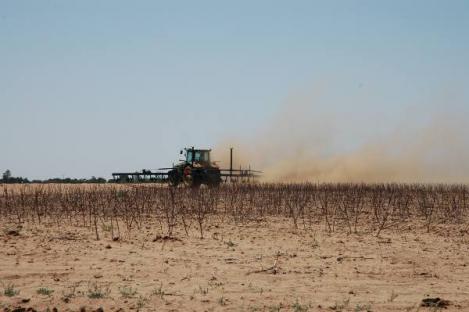
More than 99 percent of the Texas was in one level of drought or another by the last week of July.Continued to struggle with dropping irrigation well and stock-water tank levels, desiccated pastures and hay shortages.More than 90 percent of the state was in an extreme drought; 75 percent in an exceptional drought.
August 2, 2011

More than 99 percent of the state was in one level of drought or another by the last week of July, according to the U.S. Drought Monitor.
More than 90 percent of the state was in an extreme drought; 75 percent in an exceptional drought, according to the monitor. Daytime high temperatures continued to challenge or beat historical records in many parts of the state.
Throughout the state, with the exception of small pockets where there has been rain, producers continued to struggle with dropping irrigation well and stock-water tank levels, desiccated pastures and hay shortages, according to reports from Texas AgriLife Extension Service personnel.
"Different week, same song," said Rick Auckerman, AgriLife Extension agent for Deaf Smith County, west of Amarillo. "Producers are trying to run water on as many crops as possible, but the cotton is needing more water now also. The corn crop is in dire need of water, and many producers are abandoning parts or whole fields of corn production (hoping) to salvage what they can."
"What small amount of cotton that is left in the county is under irrigation, but farmers are beginning to turn the water off due to the amount of money they already have in the crop. They are worried they may not get that back in the market," said Ryan Martin, AgriLife Extension agent for Motley County, east of Lubbock. "Some of the cotton under irrigation looks very good, but once out in it, farmers realize it's just not putting on the fruit like it should be."
"All range and pastures are in extremely bad condition," said Lyle Zoeller, AgriLife Extension agent for Coryell County, west of Waco. "All classes of livestock were being fed heavily. Many cows are going to local market, as well as most calves 300 pounds and over. There is no hay available in the area; most is coming from out of state. Low-water sources are now forcing sales of cattle."
"Producers continue to cull herds as grazing gets shorter," said Mark Currie, AgriLife Extension agent for Polk County, south of Lufkin. "Time is running out for producers to make enough hay for their herds for winter feeding—even if they survive the summer. Livestock water continues to be a problem for many producers as stock tanks and creeks get lower or dry up. "
"Tropical Storm Don did not bring any measurable rain," reported Mile Gibbs, AgriLife Extension agent for Val Verde County, southeast of Fort Stockton.
"Sheep look very good considering the drought and lack of vegetation. Lamb crops are down. Northern portions of the county need some rain just to cover the burned ground from the April and May wildfires. The ground is still bald and scorched."
More information on the current Texas drought and wildfire alerts can be found on the AgriLife Extension Agricultural Drought Task Force website at http://agrilife.tamu.edu/drought/ .
You May Also Like



